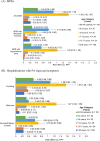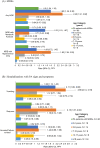Clinical burden of propionic acidemia in the United States: a claims-based study by age stratum
- PMID: 40665346
- PMCID: PMC12265150
- DOI: 10.1186/s13023-025-03901-2
Clinical burden of propionic acidemia in the United States: a claims-based study by age stratum
Abstract
Background: Patients with propionic acidemia (PA) may face recurrent metabolic decompensation events (MDEs) and multisystemic complications. This study compared characteristics and clinical outcomes of patients with PA and matched non-PA controls by age stratum.
Methods: Patients with PA from the US IQVIA PharMetrics Plus claims database (10/2015‒6/2022) had their follow-up time partitioned into age strata (0‒2, 3‒6, 7‒12, 13‒17, ≥ 18 years) and were matched 1:1 to randomly selected non-PA controls within each stratum. MDEs were identified as hospitalizations with claims for hyperammonemia and/or metabolic acidosis. Hospitalizations with claims for PA signs and symptoms were evaluated.
Results: Among 191 patients with PA and 230 matched non-PA controls (median follow-up: 2.7 years), patients with PA had more comorbidities (neurologic/nervous system, cytopenias, growth, metabolism, cardiac system; listed in order of frequency) across all age strata. The overall MDE rate for patients with PA was 0.5 per patient-year (PPY) while hospitalizations with various PA signs and symptoms ranged from 0.3 to 0.6 PPY. MDE rates were highest in those aged 3‒6 years (1.4 PPY), lowest in the 13‒17 years stratum (0.1 PPY), and rose again in adults (0.2 PPY). Patients with MDEs (31.4%) had a significantly higher burden of PA-related symptoms and comorbidities than those without; both groups showed even greater differences when compared to controls.
Conclusions: Patients with PA across all age strata, with and without MDEs, experience a substantial burden of disease-related comorbidities, complications, and healthcare visits compared with matched non-PA controls, which highlights the need for improved clinical outcomes in these patients.
Keywords: Administrative claims data; Age stratification; Clinical outcomes; Metabolic decompensation event; Propionic acidemia; Propionyl coenzyme A carboxylase.
© 2025. The Author(s).
Conflict of interest statement
Declarations. Ethical approval: Institutional Review Board review was not required for this study as it used retrospective deidentified claims data that comply with Health Insurance Portability and Accountability Act regulations. Specifically, studies using retrospective deidentified claims data do not meet the definition of research in human subjects per Title 45 of CFR, Part 46.102(e)(1) and thus, the policy for protection of human research subjects as outlined in Title 45 of CFR, Part 46, including approval or exemption of research from IRB review, does not apply to this study. Consent for publication: Not applicable. Competing interests: GB, SP, and VS are employees of Moderna Therapeutics, Inc. FM, EC, MC, AZ, JL, and LZ are employees of Analysis Group, Inc, a consulting firm that received fees from Moderna Therapeutics, Inc. to conduct this study.
Figures




Similar articles
-
Metabolic decompensation events among patients with propionic acidemia across the US: A large electronic medical record data study.Mol Genet Metab. 2025 Jun;145(2):109111. doi: 10.1016/j.ymgme.2025.109111. Epub 2025 Apr 18. Mol Genet Metab. 2025. PMID: 40311502
-
Surveillance for Violent Deaths - National Violent Death Reporting System, 50 States, the District of Columbia, and Puerto Rico, 2022.MMWR Surveill Summ. 2025 Jun 12;74(5):1-42. doi: 10.15585/mmwr.ss7405a1. MMWR Surveill Summ. 2025. PMID: 40493548 Free PMC article.
-
Sexual Harassment and Prevention Training.2024 Mar 29. In: StatPearls [Internet]. Treasure Island (FL): StatPearls Publishing; 2025 Jan–. 2024 Mar 29. In: StatPearls [Internet]. Treasure Island (FL): StatPearls Publishing; 2025 Jan–. PMID: 36508513 Free Books & Documents.
-
Nutritional interventions for survivors of childhood cancer.Cochrane Database Syst Rev. 2016 Aug 22;2016(8):CD009678. doi: 10.1002/14651858.CD009678.pub2. Cochrane Database Syst Rev. 2016. PMID: 27545902 Free PMC article.
-
A rapid and systematic review of the clinical effectiveness and cost-effectiveness of paclitaxel, docetaxel, gemcitabine and vinorelbine in non-small-cell lung cancer.Health Technol Assess. 2001;5(32):1-195. doi: 10.3310/hta5320. Health Technol Assess. 2001. PMID: 12065068
References
-
- Online Mendelian Inheritance in Man, OMIM®. Johns Hopkins University, Baltimore MDMIM, Number. 606054. August 8, 2023. Available at: https://www.omim.org/entry/606054#:~:text=Propionic%20acidemia%20is%20an.... Accessed Mar. 22, 2024.
-
- Thomas JA. Organic acidemias. In: Bernstein LE, Rohr F, Helm JR, editors. Nutrition management of inherited metabolic diseases. Cham: Springer; 2022. pp. 187–201.
-
- Kaushal M, Athalye-Jape G, Rahman MM, Motta M. Organic acidemias: clinical presentation in neonates. Newborn. 2023;2(4):263–78.
MeSH terms
Grants and funding
LinkOut - more resources
Full Text Sources
Medical

